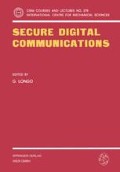Abstract
In traditional information theoretic studies, the channel is entirely passive, though possibly quite complex probabilistically. However, it sometimes happens in practice that the channel is partially controlled by an adversary (the Jammer) whose goal is to do everything in his power to make communication difficult. This possibility leads to a whole host of interesting mathematical and-engineering problems, and in this paper we will study a few of these. In the next section, we will introduce a two-person zero-sum game with mutual information as the payoff function. The first player (the Communicator) wants to maximize this function, and the second player (the Jammer) wants to minimize it. Since mutual information is convex-concave in just the right way, a generalization of Von Neumann’s minimax theorem turns out to guarantee the existence of jointly optimal saddlepoint strategies for the players. We show that these strategies are memory-less for both players.
Access this chapter
Tax calculation will be finalised at checkout
Purchases are for personal use only
Preview
Unable to display preview. Download preview PDF.
References
Barbu, V. and V. Precupanu, Convexity and Optimization in Banach Spaces. Bucharest: Editura Academiei, 1978.
Berlekamp, E. R., and Po Tong, “Interleaving,” IEEE Trans. Inform. Theory in press.
Blachman, N. M., “Communication as a Game,” 1957 WESCON Conference Record, pp. 61–66.
Blachman, N. M., “The Convolution Inequality for Entropy Powers,” IEEE Trans. Inform. Theory vol. 1T-11 (1965), pp. 267–271.
Borden, J. M., D. M. Mason, and R. J. McEliece, “Some Information-Theoretic Saddlepoints,” SIAM J. Opt. Control in press.
Dobrushyn, R. L., “Optimal Information Transmission over a Channel with Unknown Parameters,” Radiotekh. Elektron. vol. 4, no. 12, (1959), pp. 1951–1956.
Houston, S. W., “Modulation Techniques for Communication. Part 1: Tone and Noise Jamming Performance of Spread-Spectrum M-ary FSK and 2,4-ary DPSK Waveforms,” Proc. 1975 IEEE National Aeronautics and Electronics Conference (NAECON) pp. 51–53
McEliece, R. J., The Theory of Information and Coding. Reading, Mass.: Addison-Wesley, 1977.
McEliece, R. J. and W. E. Stark, “An Information-Theoretic Study of Communication in the Presence of Jamming,” Proc. 1981 IEEE International Conference on Communications pp. 45.3.1–45. 3. 5.
McEliece, R. J. and W. E. Stark, “The Optimal Code Rate vs. a Partial-Band Jammer,” Proc. 1932 Military Communications Conference pp. 8.5.1–8. 5. 4.
McEliece, R. J. and E. R. Rodemich, “Communication with MFSK vs. Optimal Jamming,” paper in preparation.
Pickholz, R. L., D. L. Schilling, and L. B. Milstein, “Theory of Spread-Spectrum Communication–a Tutorial,” IEEE Trans. Comm. vol. COM-30 (1982), pp. 855–884.
Pursley, M. B., “Spread-Spectrum Multiple-Access Communication,” pp. 139–199 in Multi-User Communication Systems G. Longo, Ed., New York: Springer-Verlag, 1981.
Scholz, R. A., “The Origins of Spread-Spectrum Communication,” IEEE Trans. Comm. vol. COM-30 (1982), pp. 822–854.
Shannon, C. E., “A Mathematical Theory of Communication,” Bell Syst. Tech. J. 27 (1948) pp. 379–423, 123–656.
Stark, W. E., Coding for Frequency-Hopped Spread-Spectrum Channels with Partial-Band Interference Ph.D. thesis, University of Illinois at Urbana-Champaign, 1982. (Reprinted as U. of I. Technical Report no. UILU-ENG 82–2211, July 1982 ).
Viterbi, A. J., “Spread-Spectrum Communications - Myths and Realities,” IEEE Comm. Mag. May 1979, pp. 11–18.
Viterbi, A. J. and I. M. Jacobs, “Advances in Coding and Modulation for Noncoherent Channels Affected by Fading, Partial-Band, and Multiple-Access Interference,” pp. 279–308 in Advances in Communication Systems vol. 4, New York: Academic Press, 1975.
Wolfowitz, J., Coding Theorems of Information Theory 3rd Ed., Berlin: Springer Verlag, 1973.
Wozencraft, J. M. and I. M. Jacobs, Principles of Communication Engineering New York: Wiley, 1965.
Author information
Authors and Affiliations
Editor information
Editors and Affiliations
Rights and permissions
Copyright information
© 1983 Springer-Verlag Wien
About this chapter
Cite this chapter
McEliece, R.J. (1983). Communication in the Presence of Jamming-An Information-Theoretic Approach. In: Longo, G. (eds) Secure Digital Communications. International Centre for Mechanical Sciences, vol 279. Springer, Vienna. https://doi.org/10.1007/978-3-7091-2640-0_8
Download citation
DOI: https://doi.org/10.1007/978-3-7091-2640-0_8
Publisher Name: Springer, Vienna
Print ISBN: 978-3-211-81784-1
Online ISBN: 978-3-7091-2640-0
eBook Packages: Springer Book Archive

